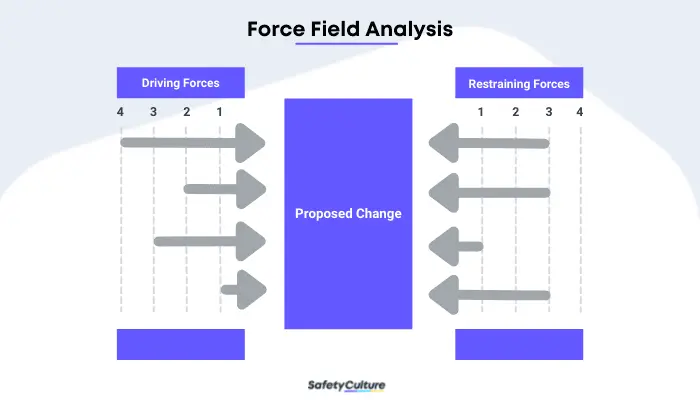What is Force Field Analysis?
Force field analysis is a decision-making tool used to determine the impact and influence of various factors before implementing changes in business processes. Once the objectives and goals are defined, this method helps put corresponding values to the listed driving forces and restraining forces of a proposed change.

Force Field Analysis
The idea behind force field analysis is that after examining the values of the factors driving or restraining the change, the method should result in a recommendation to either strengthen the forces for change or weaken the forces against change. Businesses can then use this recommendation as a well-grounded basis for deciding whether or not a proposed change should be implemented.
Development of Lewin’s Force Field Analysis
The force field analysis is a principle developed by Kurt Lewin, a German-American social psychologist. He used this concept for his work in social psychology, primarily for determining the external and internal factors that affect one’s decision. In Resolving Social Conflicts, he states that: “To bring about any change, the balance between the forces which maintain the social self-regulation at a given level has to be upset”.
This method supports the principle that in order to implement a proposed change, driving forces should be stronger than restraining forces. Businesses can now use this concept to weigh such factors before modifying their processes with the goal of improving operations.
What are the Advantages of Force Field Analysis?
One of the primary advantages of using force field analysis as a decision-making tool is that it provides a visual representation of the factors surrounding the proposed change. It also takes into consideration the impact of these factors on the final decision. Some other advantages of applying this concept are as follows:
- Promotes a collaborative set-up by involving more than one person in determining the benefits and challenges of a proposed change
- Allows for a high-level overview of the situation by analyzing all the factors and what they entail in relation to a proposed change
- Eases the evaluation process by mainly utilizing a scoring method that makes it easily quantifiable
How to Conduct a Force Field Analysis: A Step-by-Step Guide
Since force field analysis is best used in a set-up wherein a whole team, process, or organization may be affected by a possible change, remember to keep everyone on the same page by allowing them to include the factors that they consider to be important and other elements that may not initially be apparent. Conduct your force field analysis by following this step-by-step guide:
Step 1: State and describe proposal for change
Start the analysis by stating the proposed change, describing the elements, and enumerating the objectives. This would give a clear perspective on how to best address the situation. Additionally, as this method aims to improve a current process or processes, acknowledging the possible consequences of not implementing the change would also be a good starting point.
Step 2: Identify driving forces
This is the step where you’ll list down all the factors that are in favor of implementing the proposed change. Make sure to keep everyone in the loop and brainstorm with your team so that they can share their observed driving factors. List as many factors as possible to help establish the need for the change. Once done, individually place the identified factors on the left part of the diagram.
Step 3: Identify restraining forces
Subsequent to the second step, this is the part where you’ll list down all the factors opposing the implementation of the proposed change. Make sure to include as many factors as possible so that they can be weighed objectively and addressed proactively. Once done, place the identified factors on the right part of the diagram.
Step 4: Incorporate scores
Evaluate the impact of the identified factors in this step by incorporating a score to each one. The scores attached to each factor can vary depending on the user, but the most utilized are scores of 1-5 and scores of 1-10, 1 being the lowest and 5 or 10 being the highest. Just remember to be careful with how the scores correspond to the value of the factors since the scoring can be subjective. It would be best to also get your teammates’ perspective on how each factor will be scored.
Step 5: Tally, analyze, and apply
Once you’re done with giving scores to each factor, you can now tally them to see which side weighed more by summing them up. The general goal of using this type of analysis is to ensure that for a change to be implemented—the driving forces should be stronger than the restraining forces.
If the forces for change summed higher, you can proceed with the implementation of the change.
If the forces against change are higher, you can either think of processes that could strengthen the drivers or weaken the restraints. If not, it may be best to postpone or stop the plan altogether and look for other ways to address the identified need for change.
Digitize the way you Work
Empower your team with SafetyCulture to perform checks, train staff, report issues, and automate tasks with our digital platform.
Get Started for FreeExample of Force Field Analysis
Below is a situational example of using the force field analysis in the pursuit of improving business processes:
Background: A software company is planning to embrace the hybrid working arrangement for its employees. There are identified factors that support and oppose the change so management would like to weigh these and see if they can push through with the plan.
(Note: This example will utilize the scores of 1-5)
| Driving Forces | Score | Proposed Change | Restraining Forces | Score |
| Efficient use of space and workstations | 3 | Pursuing the hybrid work arrangement | Communication issues (e.g., for projects that always need quick responses) | 4 |
| Increased productivity | 4 | Potential burnout (e.g., employees working beyond their schedules) | 4 | |
| Better employee engagement | 4 | Feeling of isolation (e.g., remote employees finding it harder to communicate and adapt to new habits) | 4 | |
| Improved company culture | 5 | Increased reliance on technology | 3 | |
| Lowered costs | 4 | Having to redesign existing office space (i.e., to cater to the changes in the working arrangement) | 2 | |
| Total | 20 | Total | 17 |
From what you’ll observe in this example, the driving forces or supporting factors summed higher than the restraining forces or opposing factors. The company can take this result into consideration and push through with the planned hybrid working arrangement, and at the same time look for ways to further weaken the opposing factors before implementing the change.
SafetyCulture (formerly iAuditor) as Your Tool
Force field analysis is more efficient when relevant stakeholders can directly access files or documents to ensure that everyone is on the same page. SafetyCulture is a powerful digital tool that businesses can use when applying the force field analysis method in implementing changes. With SafetyCulture, you and your teammates can access specific files at the same time and directly input any notes that you may have by modifying access levels accordingly. SafetyCulture also allows you to do the following:
- List various driving and restraining factors using our Force Field Analysis Template, or create and customize your own template.
- Put a corresponding score to each identified force using SafetyCulture’s Scoring feature.
- Allow access to relevant stakeholders outside your organization with the Free Seats feature (available in the premium plan only.)
- Create and manage other process-improving records such as project initiation documents, making it easier for everyone to stay on the same page.
- Conduct inspections and audits on your current business processes. Find relevant and free templates in our Public Library.
- Connect SafetyCulture with your team’s other tools and experience seamless integrations.
- Train your employees on process improvement and other related concepts with online learning modules.
- Generate analysis reports and share them with your team and other stakeholders.
- Store a copy of your analysis and other data with cloud-based recordkeeping.
FAQs about Force Field Analysis
Force field analysis is simply a decision-making tool that assists businesses in deciding whether to proceed or postpone a proposed change. The name and the illustration may appear complex, but the analysis merely lists down the driving forces behind the change.
Some of the disadvantages of using force field analysis analysis include:
- The scoring system can be subjective at times since it will also depend on the perspective and priorities of the scorer. Different individuals have different perspectives on what constitutes driving forces or restraining forces.
- It is not ideal for overly complex processes with a lot of variables and elements to be taken into account.
- It can be difficult to assign an accurate numerical value for each of the forces, which also makes it hard to come up with an objective result.
Although both are decision-making tools, they are not exactly the same. Force field analysis focuses on the specific change, while SWOT analysis is a broader strategic tool used to assess an organization’s overall situation in its environment. It identifies the organization’s strengths, weaknesses, opportunities, and threats, with the goal of enhancing them.




